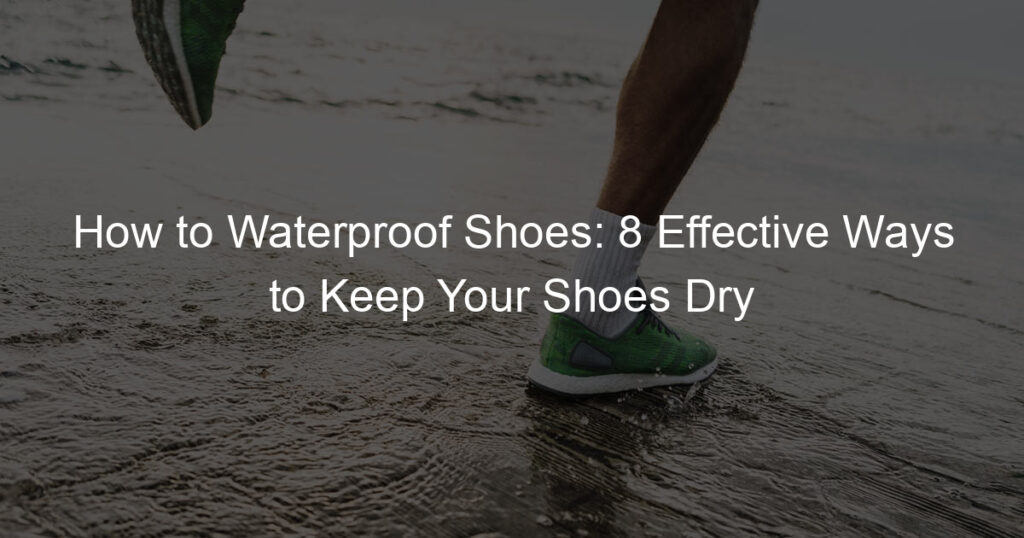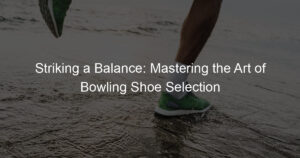Imagine confidently walking through puddles, rain, or snow without a care in the world, knowing that your shoes and feet will remain dry and comfortable. Waterproof shoes are not only a luxury but a necessity in certain weather conditions. Luckily, there’s no need to break the bank by purchasing waterproof shoes, as you can easily learn how to waterproof shoes and make your existing footwear water-resistant. In this blog post, we’ll guide you through various methods of waterproofing your shoes, from wax-based techniques to spray-on solutions, and even alternative methods for specific shoe materials. No more wet and cold feet, let’s explore how you can keep your shoes dry in any weather!
- Choose the right waterproofing method for your shoe material to keep them dry in any weather.
- Wax-based and spray-on solutions provide long-lasting protection but require proper application and maintenance.
- Alternative methods such as oils/conditioners, silicone treatments, or DIY solutions can also be used depending on the type of shoe material.
Choosing the Right Waterproofing Method
Choosing the right waterproofing method is crucial for the best results. The type of shoe material, whether it’s leather, suede, or fabric, plays a significant role in determining the ideal way to make your shoes waterproof.
We’ll discuss each of these shoe materials in detail and the most effective waterproofing techniques, so you can confidently wear your waterproof shoes in any weather.
Leather Shoes
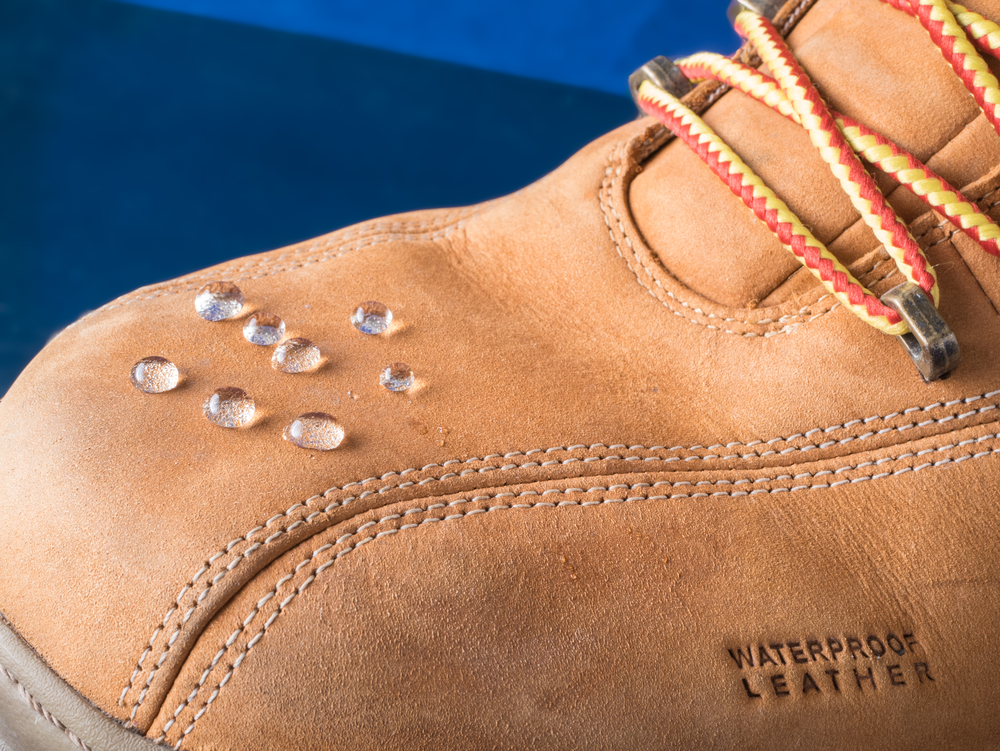
Leather shoes, including genuine leather shoes, can be treated with waterproofing agents like sprays, beeswax, candle wax, WD-40, and leather conditioners. These can be effectively used to make the shoes waterproof. To select the right waterproofing method, consider your shoe material and type of leather. Some leathers may require a more delicate approach, so be cautious when choosing the method to avoid damaging or altering the appearance of your shoes.
Mink oil is a popular choice for waterproofing leather shoes, as it not only provides a waterproof barrier but also conditions the leather to keep it soft and pliable. However, it may darken the material, so test it on a small, inconspicuous area first.
If you prefer a less invasive approach, consider using a leather waterproofing spray on your patent leather items, which is less likely to discolor the leather but may require more frequent reapplication.
Suede Shoes
Suede shoes require special care when it comes to waterproofing. Suede is the brushed underside of a leather hide, and using the wrong waterproofing method may damage or alter its texture and color. To protect your suede shoes, opt for suede-specific waterproofing sprays or waxless sprays that won’t change their appearance.
Before applying any waterproofing solution, make sure to clean your suede shoes thoroughly and remove the laces. You can use a clean suede shoe brush to remove dust and dirt, and for stubborn stains, try dry baking soda, suede stain erasers, or a mixture of water and white vinegar. Just remember to avoid using heat to dry your suede shoes, as it may cause damage.
Fabric Shoes

Fabric shoes, such as canvas shoes, can also be effectively waterproofed. Wax-based methods and fabric-specific waterproofing sprays are the most popular choices for these types of shoes. To choose the right method, first, determine the type of fabric and consider any special care requirements.
When using wax-based methods, make sure to select a wax that is suitable for your fabric shoes, such as beeswax or a material-specific wax that matches the color of your shoes. As for fabric-specific waterproofing sprays, ensure they are designed for absorbent fabrics and won’t alter the shoe’s appearance.
Don’t forget to clean your fabric shoes beyond just a quick brushing before applying any waterproofing solution.
Wax-based Waterproofing Techniques
Wax-based waterproofing techniques provide an effective and durable barrier against water, ensuring your feet stay dry even in wet conditions. However, to achieve the best results, it’s essential to apply and maintain the wax correctly.
In this section, we’ll discuss choosing the right wax, the application process, and the importance of maintenance and reapplication.
Choosing the Right Wax
Selecting the right wax for your shoe material is crucial. Beeswax is a popular choice for waterproofing shoes, as it’s a natural product that provides reliable and resilient protection against water. Other options include scent-free, colorless candle wax or specialized shoe waxes designed for specific shoe materials. Keep in mind that the wax should match the color of your shoes to avoid any discoloration.
Not only does the type of wax matter, but also the quality of the wax you choose. Opt for high-quality waxes, as they will provide better protection and last longer. Hardware stores offer a wide variety of waxes, suitable for many purposes. You can also find waxes at online retailers, like Walmart. Make sure to read the product description and reviews to ensure you’re getting the best wax for your shoes.
Application Process
Proper application of the wax is key to achieving optimal waterproofing results. Start by ensuring your shoes are clean and dry. Test the wax on a small, inconspicuous area of your shoe to ensure it doesn’t cause any discoloration or damage.
Apply the wax evenly to the entire surface of your shoe, paying special attention to seams and areas that may be more susceptible to water penetration. After applying the wax, use a hairdryer or another heat source to melt the wax into the shoe material, ensuring an even and consistent layer of protection.
Allow your shoes to air dry for at least 24 hours before wearing them in wet conditions.
Maintenance and Reapplication
Regular maintenance and reapplication of the wax are essential to maintaining the waterproofing effect on your shoes. Over time, the wax may wear off or become less effective, so it’s important to inspect your shoes regularly for signs of wear and tear.
Reapply the wax as needed, making sure to clean your shoes before each application. Following the same application process as before will ensure your shoes remain protected from water and other elements. With proper maintenance and reapplication, your shoes will stay waterproof and keep your feet dry, no matter the weather.
Spray-on Waterproofing Solutions

Spray-on waterproofing solutions offer an easy and convenient way to protect your shoes from water, dirt, and stains. These sprays provide an invisible barrier that repels water and prevents your shoes from absorbing moisture. However, they may not be as durable as wax-based methods and may require more frequent reapplication.
In this section, we’ll discuss selecting the best spray, application tips, and the importance of monitoring the longevity and reapplying the spray as needed.
Selecting the Best Spray
When choosing a spray-on waterproofing solution, consider factors such as environmental safety, effectiveness, and the potential for discoloration. Some sprays may contain harmful chemicals, so opt for eco-friendly options that won’t harm the environment. Look for sprays designed specifically for your shoe material to ensure maximum effectiveness. Some popular and reliable waterproofing sprays include Kiwi Shoe Waterproofer, Crep Protect Ultimate Rain and Stain Spray, and Scotchgard Fabric Water Shield.
As with any waterproofing method, it’s important to test the spray on a small, hidden area of your shoe to ensure it doesn’t cause any discoloration or damage. Read the product instructions and reviews to make an informed decision when selecting the best spray for your shoes.
Application Tips
To apply the waterproofing spray effectively, follow the manufacturer’s instructions and ensure proper coverage of all areas of your shoe. Hold the spray bottle about six inches away from the shoe and apply an even coating. Allow the shoe to dry for a few minutes before wiping away any drips or puddles with a damp cloth.
For optimal results, remove the laces and lift the tongue of your shoe to ensure all areas are covered. Apply the spray in a well-ventilated area, such as outdoors or in a garage, and place newspapers under your shoes to prevent overspray. Allow your shoes to air dry for the recommended amount of time before wearing them in wet conditions.
Longevity and Reapplication
Monitoring the longevity of the spray’s waterproofing effect is crucial to maintaining optimal protection for your shoes. The duration of the spray’s effectiveness may vary depending on the brand and type of spray used. Generally, spray-on waterproofing can last from a few weeks to a year, but it’s important to note that it’s not a permanent solution and requires periodic reapplication.
Inspect your shoes regularly for signs of wear and tear, and reapply the waterproofing spray as needed. Clean your shoes before each application to ensure the spray adheres properly, and follow the same application tips as before.
With proper monitoring and reapplication, your shoes will remain protected and keep your feet dry in any weather.
Alternative Waterproofing Methods
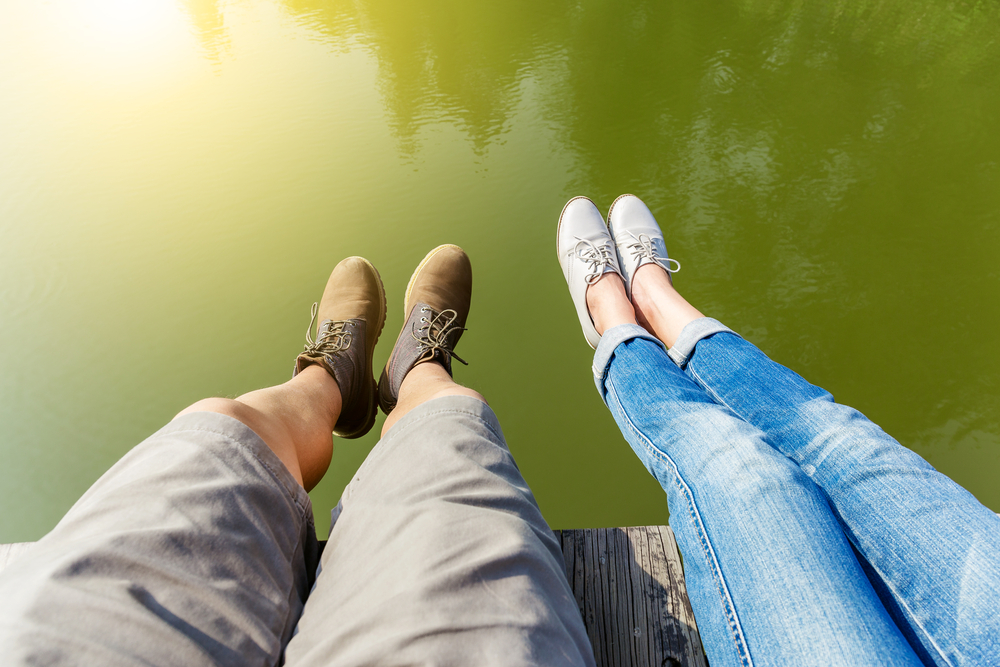
In some cases, alternative waterproofing methods may be more suitable for specific shoe materials or situations. These methods may have varying levels of effectiveness, so it’s important to consider your shoe material and the conditions in which you’ll be wearing your shoes.
In this section, we’ll discuss oils and conditioners, silicone treatments, and DIY solutions as alternative waterproofing methods.
Oils and Conditioners
Oils and conditioners, such as mink oil, can be used to waterproof and restore leather shoes. These products not only provide a waterproof barrier but also condition the leather to make it softer and more pliable. However, they may darken the material, so it’s important to test them on a small, inconspicuous area of your shoe before applying them to the entire surface.
To apply oils and conditioners, evenly distribute the product onto the external material of your shoes using a rag or shoe cloth. Wipe off any excess product and allow your shoes to dry before wearing them in wet conditions.
Keep in mind that oils and conditioners may not be suitable for all shoe materials, so always check the manufacturer’s recommendations before using them.
Silicone Treatments
Silicone treatments can provide a waterproof barrier for various shoe materials, making them an effective alternative to wax-based methods and spray-on solutions. Some popular silicone treatments include Kiwi’s silicone-based spray for leather shoes and Nikwax Fabric and Leather Proof. These treatments can be particularly useful for shoes made from materials that may not be compatible with wax or oil-based waterproofing methods.
When using silicone treatments, follow the manufacturer’s instructions and ensure proper coverage of all areas of your shoe. As with any waterproofing method, test the treatment on a small, hidden area of your shoe to ensure it doesn’t cause any discoloration or damage. Reapply the treatment as needed to maintain optimal protection for your shoes.
DIY Solutions
DIY solutions, such as using WD-40 or homemade waterproofing mixtures, can be effective in a pinch but may have drawbacks or limited effectiveness. For example, some DIY solutions may leave your shoes looking and feeling greasy, not providing long-term protection, or attracting and holding dirt particles.
When using DIY solutions, always test the product on a small, inconspicuous area of your shoe to ensure it doesn’t cause any discoloration or damage. Follow any available instructions or guidelines for the specific DIY solution you’re using, and reapply as needed to maintain the waterproofing effect.
Waterproof Shoe Accessories
In addition to waterproofing your shoes, you can also use waterproof shoe accessories to provide extra protection in wet conditions. Waterproof shoe covers can safeguard your shoes from the weather and accidental spills, while waterproof socks can help keep your feet dry even if your shoes aren’t completely waterproof.
By using a combination of waterproofing methods and accessories, you can ensure that your feet stay dry and comfortable no matter what the weather brings.
Caring for Waterproofed Shoes
Caring for waterproofed shoes involves proper storage, cleaning, and maintenance to ensure the waterproofing effect lasts as long as possible. Store your shoes in a cool, dry place away from direct sunlight and high heat. Clean your shoes regularly to remove dirt and debris that may reduce the effectiveness of the waterproofing treatment.
Reapply waterproofing treatments as needed, following the same application process as before. By taking good care of your waterproofed shoes, you can extend their lifespan and keep your feet dry in any weather.
How to Choose Waterproof Footwear
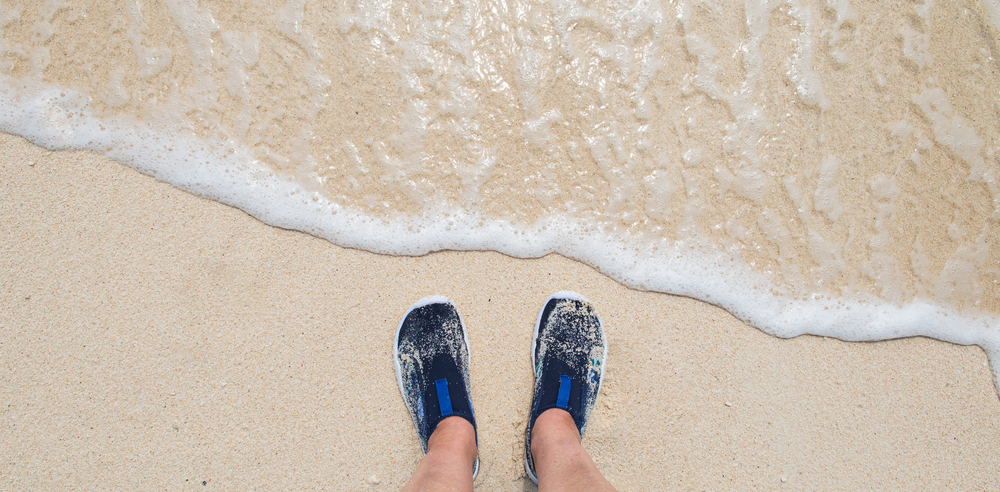
Choosing waterproof footwear from the start can save you time and effort in waterproofing your existing shoes. Many retailers offer a wide range of stylish and functional waterproof footwear options for various weather conditions, such as rain boots, hiking boots, waterproof sneakers, and waterproof boots. To ensure your feet stay dry and comfortable, it’s a great idea to wear waterproof shoes.
When selecting waterproof footwear, consider factors such as breathability, comfort, and durability, as well as the specific weather conditions in which you’ll be wearing them. With the right waterproof footwear, you can confidently stride through puddles, rain, or snow, knowing that your feet will remain dry and comfortable.
Summary
In conclusion, knowing how to waterproof your shoes is a valuable skill that can save you money and keep your feet dry in any weather. Whether you opt for wax-based techniques, spray-on solutions, or alternative methods, proper application and maintenance are key to ensuring the best results. By learning about the various waterproofing methods and choosing the right one for your shoe material, you can confidently wear your waterproof shoes and enjoy the comfort of dry feet no matter the weather. So, go ahead and embrace the rain – your newly waterproofed shoes are ready for anything!
Frequently Asked Questions
Can I spray my shoes to make them waterproof?
Yes, you can spray your shoes to make them waterproof. Sprays are a convenient way to protect your footwear from the elements and maintain their quality for longer.
As such, you should consider investing in a suitable product before taking your shoes on your next outdoor adventure.
Does WD 40 make shoes waterproof?
WD40 is a great multi-purpose product and can be used to help make leather shoes and boots waterproof. When applied properly, the product creates a protective barrier on the surface of the shoe or boot that repels water.
Therefore, it can help make your footwear more resistant to wet conditions.
Is leather waterproof?
Overall, leather is water-resistant, not waterproof. This means it will protect your belongings from a light rain shower or snow, but can be prone to water damage when exposed to significant amounts of liquid over a long period of time.
Therefore, in order to keep your leather items in pristine condition, it is important to take proper care of them and protect them from moisture.
Is suede waterproof?
Unfortunately, suede is not waterproof and can easily get ruined by water or moisture.
However, you can make it water-resistant with the help of spray sealants. Applying such protective sprays is a great way to make your suede last longer in wet weather conditions.
What are the best waterproofing methods for leather shoes?
For the best results in waterproofing leather shoes, it is recommended to use sprays or beeswax, both of which provide good protection while allowing the leather to retain its breathability. Candle wax and WD-40 are also viable options for light water resistance.
Finally, leather oils and conditioners should be used regularly to maintain waterproof properties.

